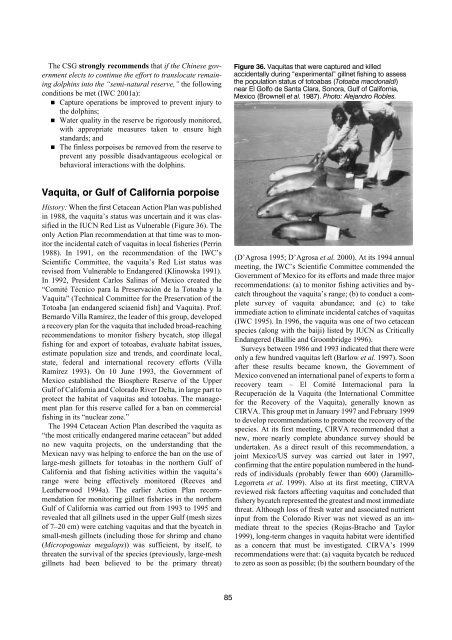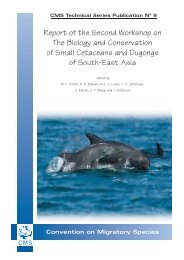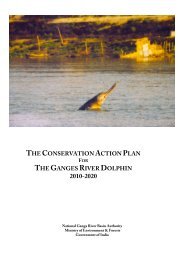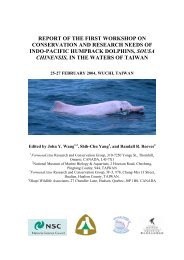Dolphins, Whales and Porpoises: 2002-2010 Conservation - IUCN
Dolphins, Whales and Porpoises: 2002-2010 Conservation - IUCN
Dolphins, Whales and Porpoises: 2002-2010 Conservation - IUCN
You also want an ePaper? Increase the reach of your titles
YUMPU automatically turns print PDFs into web optimized ePapers that Google loves.
The CSG strongly recommends that if the Chinese government<br />
elects to continue the effort to translocate remaining<br />
dolphins into the “semi-natural reserve,” the following<br />
conditions be met (IWC 2001a):<br />
Capture operations be improved to prevent injury to<br />
the dolphins;<br />
Water quality in the reserve be rigorously monitored,<br />
with appropriate measures taken to ensure high<br />
st<strong>and</strong>ards; <strong>and</strong><br />
The finless porpoises be removed from the reserve to<br />
prevent any possible disadvantageous ecological or<br />
behavioral interactions with the dolphins.<br />
Figure 36. Vaquitas that were captured <strong>and</strong> killed<br />
accidentally during “experimental” gillnet fishing to assess<br />
the population status of totoabas (Totoaba macdonaldi)<br />
near El Golfo de Santa Clara, Sonora, Gulf of California,<br />
Mexico (Brownell et al. 1987). Photo: Alej<strong>and</strong>ro Robles.<br />
Vaquita, or Gulf of California porpoise<br />
History: When the first Cetacean Action Plan was published<br />
in 1988, the vaquita’s status was uncertain <strong>and</strong> it was classified<br />
in the <strong>IUCN</strong> Red List as Vulnerable (Figure 36). The<br />
only Action Plan recommendation at that time was to monitor<br />
the incidental catch of vaquitas in local fisheries (Perrin<br />
1988). In 1991, on the recommendation of the IWC’s<br />
Scientific Committee, the vaquita’s Red List status was<br />
revised from Vulnerable to Endangered (Klinowska 1991).<br />
In 1992, President Carlos Salinas of Mexico created the<br />
“Comité Técnico para la Preservación de la Totoaba y la<br />
Vaquita” (Technical Committee for the Preservation of the<br />
Totoaba [an endangered sciaenid fish] <strong>and</strong> Vaquita). Prof.<br />
Bernardo Villa Ramírez, the leader of this group, developed<br />
a recovery plan for the vaquita that included broad-reaching<br />
recommendations to monitor fishery bycatch, stop illegal<br />
fishing for <strong>and</strong> export of totoabas, evaluate habitat issues,<br />
estimate population size <strong>and</strong> trends, <strong>and</strong> coordinate local,<br />
state, federal <strong>and</strong> international recovery efforts (Villa<br />
Ramírez 1993). On 10 June 1993, the Government of<br />
Mexico established the Biosphere Reserve of the Upper<br />
Gulf of California <strong>and</strong> Colorado River Delta, in large part to<br />
protect the habitat of vaquitas <strong>and</strong> totoabas. The management<br />
plan for this reserve called for a ban on commercial<br />
fishing in its “nuclear zone.”<br />
The 1994 Cetacean Action Plan described the vaquita as<br />
“the most critically endangered marine cetacean” but added<br />
no new vaquita projects, on the underst<strong>and</strong>ing that the<br />
Mexican navy was helping to enforce the ban on the use of<br />
large-mesh gillnets for totoabas in the northern Gulf of<br />
California <strong>and</strong> that fishing activities within the vaquita’s<br />
range were being effectively monitored (Reeves <strong>and</strong><br />
Leatherwood 1994a). The earlier Action Plan recommendation<br />
for monitoring gillnet fisheries in the northern<br />
Gulf of California was carried out from 1993 to 1995 <strong>and</strong><br />
revealed that all gillnets used in the upper Gulf (mesh sizes<br />
of 7–20 cm) were catching vaquitas <strong>and</strong> that the bycatch in<br />
small-mesh gillnets (including those for shrimp <strong>and</strong> chano<br />
(Micropogonias megalops)) was sufficient, by itself, to<br />
threaten the survival of the species (previously, large-mesh<br />
gillnets had been believed to be the primary threat)<br />
(D’Agrosa 1995; D’Agrosa et al. 2000). At its 1994 annual<br />
meeting, the IWC’s Scientific Committee commended the<br />
Government of Mexico for its efforts <strong>and</strong> made three major<br />
recommendations: (a) to monitor fishing activities <strong>and</strong> bycatch<br />
throughout the vaquita’s range; (b) to conduct a complete<br />
survey of vaquita abundance; <strong>and</strong> (c) to take<br />
immediate action to eliminate incidental catches of vaquitas<br />
(IWC 1995). In 1996, the vaquita was one of two cetacean<br />
species (along with the baiji) listed by <strong>IUCN</strong> as Critically<br />
Endangered (Baillie <strong>and</strong> Groombridge 1996).<br />
Surveys between 1986 <strong>and</strong> 1993 indicated that there were<br />
only a few hundred vaquitas left (Barlow et al. 1997). Soon<br />
after these results became known, the Government of<br />
Mexico convened an international panel of experts to form a<br />
recovery team – El Comité Internacional para la<br />
Recuperación de la Vaquita (the International Committee<br />
for the Recovery of the Vaquita), generally known as<br />
CIRVA. This group met in January 1997 <strong>and</strong> February 1999<br />
to develop recommendations to promote the recovery of the<br />
species. At its first meeting, CIRVA recommended that a<br />
new, more nearly complete abundance survey should be<br />
undertaken. As a direct result of this recommendation, a<br />
joint Mexico/US survey was carried out later in 1997,<br />
confirming that the entire population numbered in the hundreds<br />
of individuals (probably fewer than 600) (Jaramillo-<br />
Legorreta et al. 1999). Also at its first meeting, CIRVA<br />
reviewed risk factors affecting vaquitas <strong>and</strong> concluded that<br />
fishery bycatch represented the greatest <strong>and</strong> most immediate<br />
threat. Although loss of fresh water <strong>and</strong> associated nutrient<br />
input from the Colorado River was not viewed as an immediate<br />
threat to the species (Rojas-Bracho <strong>and</strong> Taylor<br />
1999), long-term changes in vaquita habitat were identified<br />
as a concern that must be investigated. CIRVA’s 1999<br />
recommendations were that: (a) vaquita bycatch be reduced<br />
to zero as soon as possible; (b) the southern boundary of the<br />
85





